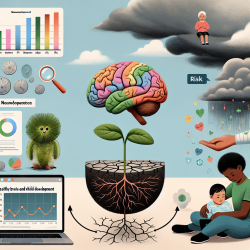Introduction
As practitioners in the field of speech-language pathology, we often focus on data-driven decisions to enhance outcomes for children. Similarly, the research article "Through what mechanisms do protected areas affect environmental and social outcomes?" by Ferraro and Hanauer emphasizes the importance of understanding mechanisms to improve environmental and social outcomes. This blog aims to bridge the gap between environmental research and speech-language pathology by exploring how practitioners can apply evidence-based mechanisms to improve their practice.
Understanding Mechanisms
The concept of mechanisms is crucial in both environmental science and speech-language pathology. In the context of protected areas, mechanisms refer to the processes through which interventions lead to desired outcomes. For example, protected areas may enhance biodiversity by preventing infrastructure development, which in turn benefits local communities. Similarly, in speech-language pathology, mechanisms such as specific therapeutic interventions can lead to improved communication skills in children.
Applying Mechanisms in Practice
Practitioners can enhance their skills by understanding and implementing mechanisms that have been empirically supported. Here are some strategies to consider:
- Identify Key Mechanisms: Just as protected areas rely on specific mechanisms to achieve outcomes, practitioners should identify key mechanisms that drive success in their interventions. This could include evidence-based strategies such as modeling, reinforcement, and scaffolding in therapy sessions.
- Data-Driven Decisions: Utilize data to evaluate the effectiveness of different mechanisms. For example, track progress through standardized assessments to determine which interventions yield the best outcomes for children.
- Collaborate and Share Knowledge: Engage with other professionals to share insights and evidence about effective mechanisms. Collaboration can lead to a deeper understanding of what works and why, similar to how researchers collaborate to understand protected area impacts.
Encouraging Further Research
While the current evidence base is limited, practitioners are encouraged to engage in further research to strengthen their understanding of mechanisms. Consider conducting small-scale studies or participating in larger research projects to contribute to the evidence base. This aligns with the call for more precise theories and empirical designs in the study of protected areas.
Conclusion
Understanding and implementing evidence-based mechanisms is vital for practitioners aiming to improve outcomes for children. By drawing parallels between environmental research and speech-language pathology, we can enhance our practice and contribute to better outcomes. To delve deeper into the original research, please follow this link: Through what mechanisms do protected areas affect environmental and social outcomes?










